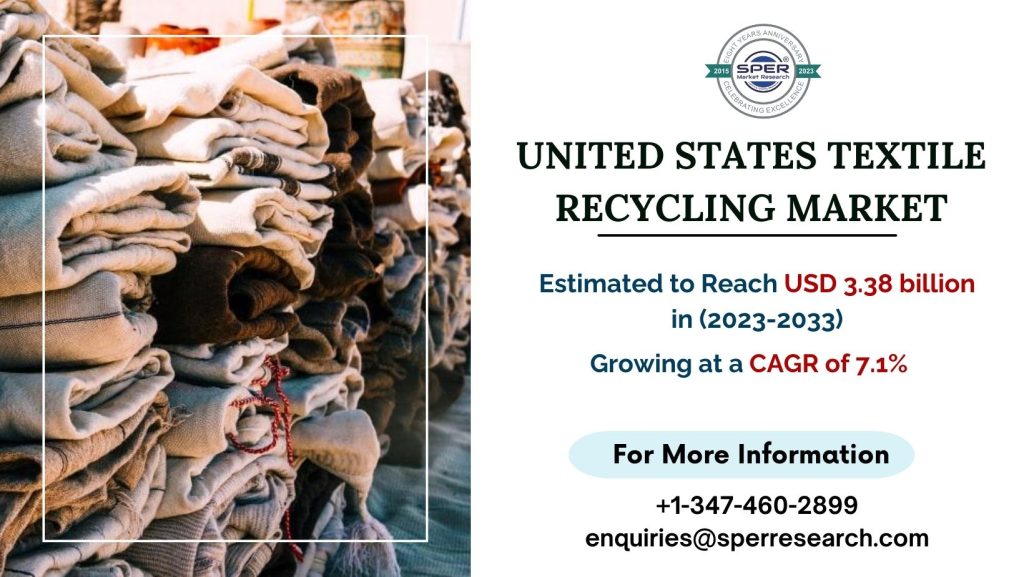Textile recycling is the process of gathering, sorting, and processing used textiles to make new products. It involves several processes such as shredding, spinning, weaving, and dying to create recycled textiles that can be used for clothing, home furnishings, and industrial goods. Recycling textiles reduces the harm that the textile industry does to the environment, preserves resources, and keeps textiles out of landfills.
According to SPER market research, ‘United States Textile Recycling Market Size- By Product Type, By Textile Wastes, By Distribution Channels, By End Use – Regional Outlook, Competitive Strategies and Segment Forecast to 2033’state that the United States Textile Recycling Market is predicted to reach USD 3.38 Billion by 2033 with a CAGR of 7.1%.
The growing emphasis on sustainability and the circular economy is expected to propel the US textile recycling market towards a bright future. It is anticipated that the market would expand steadily as more people, companies, and governments realise how crucial textile recycling is to cutting waste and saving resources. The efficiency and calibre of recycled textiles will be greatly enhanced by technological developments. Increased innovation in recycling techniques, like fibre regeneration and chemical recycling, will create new opportunities for the market and make it possible to produce high-quality recycled textiles. Stakeholder alliances and collaborations will keep the textile recycling ecosystem strong. These partnerships will result in the creation of stronger collection networks, more effective sorting facilities, and cutting-edge recycling technologies.
Challenges in the US Textile Recycling Market:
- Low participation rates are caused by a lack of awareness among consumers and businesses regarding the availability and advantages of textile recycling.
- Problems with Collection and Sorting: Lack of infrastructure, ineffective collection methods, and logistical concerns can make gathering and sorting old textiles difficult.
- Concerns about Quality and Performance: Recycled textiles may be seen as having lower quality and performance than virgin materials, which can prevent them from being adopted in some applications.
Request For Free Sample Report @ https://www.sperresearch.com/report-store/united-states-textile-recycling-market.aspx?sample=1
COVID Impact: The American textile recycling industry has been greatly damaged by the COVID-19 outbreak. Reduced collection of used textiles from homes and businesses is the result of supply networks being interrupted by lockdown measures and limitations. The problems got worse when recycling plants closed and the market for recovered products declined. The processing and sorting of textiles has also been hampered by hygienic restrictions and safety worries. The industry’s recovery has been hampered by these disruptions, which have also impeded the expansion of the textile recycling sector.
The Northeast region of the United States, which includes states like Maine, New Hampshire, Vermont, Massachusetts, Rhode Island, Connecticut, New York, New Jersey, and Pennsylvania, is known for its high population density, emphasis on urbanisation, and commitment to sustainability. These factors have an impact on the textile recycling business in this region. Big cities like New York City, which serve as centres of the fashion industry, encourage the availability of programmes and services for recycling textiles. The Midwest region, which includes states like Ohio, Indiana, Michigan, Illinois, and others, is a mix of rural and urban areas. Manufacturing centres in the region generate a large amount of textile waste, which drives the need for recycling services. Similar to this, the West and South exhibit distinct market dynamics brought forth by urbanisation, environmental initiatives, and a variety of economic activity.
Additionally, some of the market key players are American-Recyclers, Ambercycle, Inc., Circ LLC, Evrnu Inc., For Days, Inc., Lenzing AG, Unifi, Inc., Others.
United States Textile Recycling Market Segmentation:
The SPER Market Research report seeks to give market dynamics, demand, and supply forecasts for the years up to 2033. This report contains statistics on product type segment growth estimates and forecasts.
By Product Type: Based on the Product Type, United States Textile Recycling Market is segmented as; Cotton Recycling, Nylon & Nylon Fibre Recycling, Polyester & Polyester Fibre Recycling, Wool Recycling, Others.
By Textile Wastes: Based on the Textile Wastes, United States Textile Recycling Market is segmented as; Post-consumer Textile, Pre-consumer Textile.
By Distribution Channels: Based on the Distribution Channels, United States Textile Recycling Market is segmented as; Online Channel, Retail & Departmental Stores.
By End Use: Based on the End Use, United States Textile Recycling Market is segmented as; Apparel, Home Furnishings, Industrial, Non-woven, Others.
By Region: This research also includes data for Midwest Region, Northeast Region, South Region, West Region.
This study also encompasses various drivers and restraining factors of this market for the forecast period. Various growth opportunities are also discussed in the report.
For More Information, refer to below link:-
United States Textile Recycling Market Future Outlook
Related Reports:
Follow Us –
LinkedIn | Instagram | Facebook | Twitter
Contact Us:
Sara Lopes, Business Consultant – U.S.A.
SPER Market Research
+1-347-460-2899



